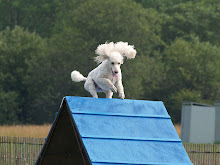The following picture is of Apache. He just turned 11 years old. He is recovering from partially torn cruciate ligaments on both knees. He had stem cell therapy 2 weeks ago. Please excuse his massive winter coat! He last had a hair cut in early November but was left long for winter. His feet and face were tidied for Christmas and then after his knee problem and then procedure his coat has just kept growing and growing.
I have repeated the entire process now that Apache has had his spring haircut. In the wooly photo his right front foot is a hair forward and in the naked photo the same leg is a hair too far back. Not bad for working all by myself though:)

Apache has a docked tail with about half of its original length. His tail is set fairly low and his pelvis is fairly sloping. Apache's ischium extends well past his tail set creating a fairly extensive "shelf". His femur and his tibia are fairly equal with moderate angles connecting them.
Apache's front legs are a little bit too far forward. His neck appears a little short but I think that is partly the way his head is being held. Apache has ewe neck. His shoulder appears to be longer than his upper arm and the shoulder seems to be very straight.
Apache is a speed demon. He is very fast with a ton of power behind him. He does not turn well either in agility or just chasing his sisters. He can be an efficient jumper, however, it was not uncommon for bars to come down when he jumped 26". At 22" bars rarely fall. He tucks his paws up under his chin when he jumps and is evenly split whether he pulls his rear feet up under his belly or tucks them back behind him. Apache lowers his head to jump, but he is extremely upright when he is weaving - fast and powerful but his head is very high. Apache is a wonderful swimmer and would spend all day swimming and retrieving if given the choice.

So, now it appears obvious that Apache has a very flat and short pelvis. His femur is long as is his tibia. It looks like his tibia is longer than the femur by a bit. His stifle seems to be a bit high. It would be nice to see it a little lower more in line with his elbow. Apache does seem to to have nice angulation in the rear. He seems to have quite a wide thigh but that is perhaps exaggerated in a heavy winter coat. Now that he is all shaved I can see the loss of muscle definition following almost 3 months of leash walking and crate rest. He is usually much more muscular in his hind end.
Apache's front is very straight. He has a very long and straight shoulder. His forearm is almost as long as his shoulder and steeply angled. His elbow is directly beneath his withers. Apache has a ewe neck and easily lowers his head when jumping. Comparing the two photos makes it really clear, how important a "perfect" photo is for analysis. I think if you kinda split the difference between the two photos you probably have a good idea of the actual front assembly. His neck appears longer without it being held and his front legs are not as far forward as I thought earlier.
Can you say, LONG BACK! He appears to have a long loin and with his short, flat pelvis and straight shoulder, most of the length of this dog is in his back. This makes sense because Apache has been plagued with back problems his whole career. He does seem to have a rise over his loin. The old photo made it look like Apache had a nice top line. The naked version shows a dip between front legs and back although the rise over the loin is still noticeable.


Hmmm.... well I would say that Apache is the opposite of well balanced. He is heavily on his front end. I wonder if this explains his turning problems. If he has a ton of power coming from behind and yet his balance is on his front end, where does he manage to get the turn from. Apache in full speed running reminds me of the greyhounds running on the hunt. He does tend to wipe out when turning at full speed. I have seen him tumbling across the lawn many, many times.
Here an example of a greyhound.

I definitely see the resemblance in the front end. Very straight. The greyhound has a much longer and more sloping pelvis. I see the greyhound also has a longer tibia than femur.






